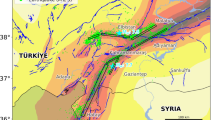Abstract
Analysis of gentle, intermediate, and steep dip angles of fault planes in earthquake sources of the Baikal region is carried out with the slips in seismic sources being taken into account. The areas where normal faulting slips at steep, intermediate, and gentle angles took place are distinguished, and this can be interpreted as transformation of a steep dip to gentle one. It is found that the increase in energy class is accompanied by the number of earthquakes with steep dip angles, whereas the proportion of earthquakes with intermediate angles decreases, and the fraction of earthquakes with gentle angles remains quasi-stable and small.
Similar content being viewed by others
References
A. V. Peive, Izv. Akad. Nauk SSSR, Ser. Geol., No. 3, 57–71 (1956).
Letnikov, F.A., Synergetics of Geological Systems (Nauka, Novosibirsk, 1992) [in Russian].
K. Zh. Seminskii, Internal Structure of Continental Fault Zones. Tectonophysical Aspect (Siberian Branch Russ. Acad. Sci., Novosibirsk, 2003) [in Russian].
Lithosphere of Central Asia (The Main Research Results of Institute of the Earth’s Crust Siberian Branch Russian Academy of Sciences for the Period from 1992 up to 1996 Years), Ed. by N. A. Logachev (Nauka, Novosibirsk, 1996) [in Russian].
M. G. Dem’yanovich, A. V. Klyuchevskii, and V. M. Dem’yanovich, Litosfera, No. 3, 3–18 (2008).
C. H. Scholz, The Mechanics of Earthquakes and Faulting (Cambridge Univ. Press, Cambridge, 2002).
L. A. Misharina, Earth Stresses in Rift Zones (Nauka, Moscow, 1967) [in Russian].
A. V. Vvedenskaya, The Way for Investigating Stresses and Fractures in Earthquakes Focuses with the Help of Dislocation Theory (Nauka, Moscow, 1969) [in Russian].
A. V. Klyuchevskii, V. M. Dem’yanovich, and V. I. Dzhurik, Geol. Geofiz. 50 (3), 279–288 (2009).
Modern Dynamic of Continental Lithosphere, Ed. by N. A. Logachev (Nedra, Moscow, 1995) [in Russian].
A. V. Klyuchevskii, Dokl. Earth Sci. 457 (2), 971–975 (2014).
J. N. Brune and W. Thatcher, in International Geophysics, Vol. 81A: International Handbook of Earthquake and Engineering Seismology, Part A (Acad. Press, 2002), pp. 560–569.
B. Wernicke, Nature 291, 645–648 (1981).
B. Wernicke, J. Geophys. Res. 100 (B10), 20159–20174 (1995).
A. V. Klyuchevskii, J. Geodyn. 49 (1), 19–23 (2010).
Author information
Authors and Affiliations
Corresponding author
Additional information
Original Russian Text © V.M. Dem’yanovich, A.V. Klyuchevskii, 2018, published in Doklady Akademii Nauk, 2018, Vol. 479, No. 5, pp. 536–541.
Rights and permissions
About this article
Cite this article
Dem’yanovich, V.M., Klyuchevskii, A.V. Faults and Source Parameters of Earthquakes in the Baikal Rift Zone: Dip Angles of Fault Planes. Dokl. Earth Sc. 479, 433–438 (2018). https://doi.org/10.1134/S1028334X18040128
Received:
Published:
Issue Date:
DOI: https://doi.org/10.1134/S1028334X18040128




